

This chapter introduces basic vocabulary words and sentence structures that are needed for identifying people and things.
 Hajimemashite
HajimemashiteWhen you want to introduce yourself to someone, approach to him/her and say  Hajimemashite. This literally means Beginning, but its function is to clarify the fact that you are meeting the person for the very first time and are willing to get to know him/her. Then say your name and add
Hajimemashite. This literally means Beginning, but its function is to clarify the fact that you are meeting the person for the very first time and are willing to get to know him/her. Then say your name and add  desu and say
desu and say  Yoroshiku onegai shimasu, which literally means Please be nice to me but actually shows your modest attitude and your desire to have a good relationship with the person. If someone says this to you, you should respond with
Yoroshiku onegai shimasu, which literally means Please be nice to me but actually shows your modest attitude and your desire to have a good relationship with the person. If someone says this to you, you should respond with  Kochira koso yoroshiku onegai shimasu, which means It’s me who should say that.
Kochira koso yoroshiku onegai shimasu, which means It’s me who should say that.
When addressing a non-family person, try to use his or her occupational title, such as  sensei (teacher) or
sensei (teacher) or  shach
shach (company president), after his or her family name. If an occupational title is not available, use a respectful title such as
(company president), after his or her family name. If an occupational title is not available, use a respectful title such as  san after his or her family name or given name. There are additional respectful titles, but
san after his or her family name or given name. There are additional respectful titles, but  san is most neutral and versatile. Make sure not to use an occupational title or a respectful title after your name, even if other people keep addressing you with them. The following are some examples of occupational titles and their use with the family name Tanaka:
san is most neutral and versatile. Make sure not to use an occupational title or a respectful title after your name, even if other people keep addressing you with them. The following are some examples of occupational titles and their use with the family name Tanaka:

The following are some respectful titles:


Jane White introduces herself to Keiko Hayashi at a party. Complete their conversation.
 Dochira kara desu ka (Where are you from?)
Dochira kara desu ka (Where are you from?)After you introduce yourself to someone for the first time, you might next want to ask the person where he/she is from. Here you’ll learn how to do that.
 dochira and the particle
dochira and the particle  kara
kara dochira literally means which way but is also used as a polite version of
dochira literally means which way but is also used as a polite version of  doko (where).
doko (where).  kara is the particle that means from. If you are from Boston, you can say
kara is the particle that means from. If you are from Boston, you can say  Bosuton kara desu (I’m from Boston.). To find out where a person is from, you can ask
Bosuton kara desu (I’m from Boston.). To find out where a person is from, you can ask 
 Dochira kara desu ka (Where are you from?).
Dochira kara desu ka (Where are you from?).
 anata,
anata,  watashi, and
watashi, and  boku
bokuWhen you are asking someone where he/she is from, you do not need to say  anata (you) because it would be obvious, unnatural, and sound like translation. Instead, you can say the name of the person you are talking to. For example, if you are talking to Ms. Hayashi, you can ask her Hayashi-san wa dochira kara desu ka, which means Where are you from, Ms. Hayashi? It is fine to use
anata (you) because it would be obvious, unnatural, and sound like translation. Instead, you can say the name of the person you are talking to. For example, if you are talking to Ms. Hayashi, you can ask her Hayashi-san wa dochira kara desu ka, which means Where are you from, Ms. Hayashi? It is fine to use  watashi to refer to yourself. If you are a male, you may also use
watashi to refer to yourself. If you are a male, you may also use  boku to refer to yourself.
boku to refer to yourself.
If someone asks you where you are from, you can answer the question with the name of a country, a region, or a city, depending on the context. The following are names of some countries, regions, and cities:
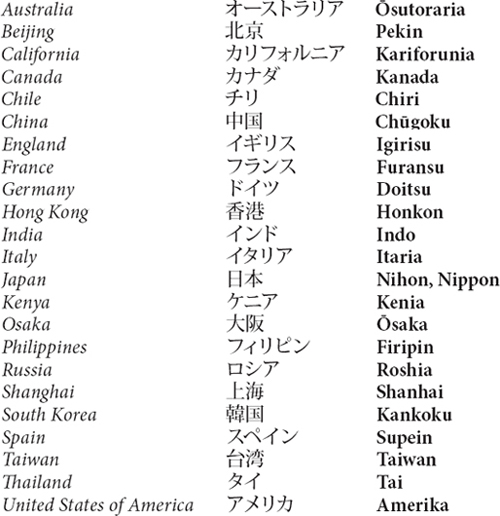

Ms. White asks Ms. Hayashi where she is from. Complete their conversation.

Match the country names written in Japanese with their English equivalents.

Find nine country names in the puzzle, either vertically (top to bottom) or horizontally (left to right).

Translate the following sentences into Japanese.
1. Meilin ( Meirin) is from Beijing.
Meirin) is from Beijing.
2. Yumiko ( Yumiko) is from Tokyo.
Yumiko) is from Tokyo.
3. Thomas ( T
T masu) is from Canada (
masu) is from Canada ( Kanada).
Kanada).
4. Emily ( Emir
Emir ) is from England (
) is from England ( Igirisu).
Igirisu).

State where you are from in Japanese.
Sometimes you want to be able to describe the nationality or language of another person. Here you will learn the proper form as well as the words for some nationalities and languages.
 wa …
wa …  desu
desuWhen describing someone, the first step is to refer to that person and add the topic marker  wa, as you have already done in this chapter. For example, if you are talking about Ken, you say
wa, as you have already done in this chapter. For example, if you are talking about Ken, you say 
 Ken-san wa. Then you say Ken’s nationality—for example,
Ken-san wa. Then you say Ken’s nationality—for example,  Amerika-jin (American)—and add the copular verb
Amerika-jin (American)—and add the copular verb  desu. For example:
desu. For example:
Ken-san wa Amerika-jin desu.
Ken is an American.
If you want say that someone is not a particular nationality, replace  desu with
desu with 
 ja arimasen or with
ja arimasen or with  ja nai desu. For example:
ja nai desu. For example:
Ken-san wa Amerika-jin ja arimasen.
Ken-san wa Amerika-jin ja nai desu.
Ken is not an American.
In a formal speech context or in writing, replace  ja in these negative copular verbs with
ja in these negative copular verbs with  de wa.
de wa.
 mo
moIf the same situation applies to another person, just use  mo to mark the additional person instead of using
mo to mark the additional person instead of using  wa. For example,
wa. For example,  Biru-san mo Amerika-jin desu means Bill is also an American.
Biru-san mo Amerika-jin desu means Bill is also an American.
To refer to a person’s nationality, use the country name and add  jin (person). The following are some examples:
jin (person). The following are some examples:

To refer to a language, you add  go (language) after the country name (or region name):
go (language) after the country name (or region name):
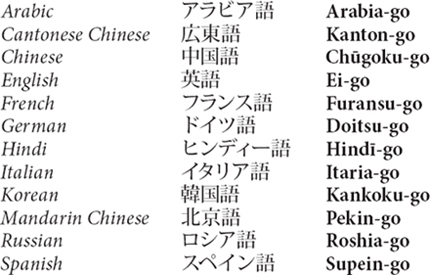

How do you say the following in Japanese?
1. an Italian (person) _________________________________________
2. a Canadian (person) _________________________________________
3. a Filipino (person) _________________________________________
4. an Indian (person) _________________________________________

Translate the following sentences into Japanese.
1. Takeshi ( Takeshi-san) is Japanese.
Takeshi-san) is Japanese.
2. Heejeong ( H
H jon-san) is Korean.
jon-san) is Korean.
3. Professor Brown ( Buraun sensei) is a Canadian.
Buraun sensei) is a Canadian.
4. Mr. Chen ( Chen-san) is Chinese.
Chen-san) is Chinese.
5. Meilin ( Meirin-san) is also Chinese.
Meirin-san) is also Chinese.
6. George ( J
J ji-san) is not an American.
ji-san) is not an American.

Describe yourself by stating where you are from and your nationality in Japanese.
 ano …
ano …To refer to a person, the easiest way is to use the person’s name. However, if you don’t know the name of the person, but your conversational partner can actually see the person, you can use a demonstrative adjective and a common noun. For example,  ano hito means that person over there.
ano hito means that person over there.
 ano
anoTo refer to a person you and your conversational partner can see, use a demonstrative adjective like  ano (that) and a common noun like
ano (that) and a common noun like  hito (person) and
hito (person) and  gakusei (student). For example:
gakusei (student). For example:
Ano hito wa Amerika-jin desu.
That person over there is an American.
Additional demonstrative adjectives are discussed later in this chapter.
It is useful to know a common noun like  hito so you can refer to someone as that person, that man, or that girl. The following are some common nouns for people:
hito so you can refer to someone as that person, that man, or that girl. The following are some common nouns for people:
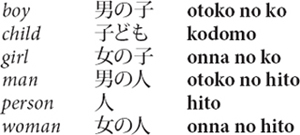

Translate the following sentences into Japanese.
1. That woman is Japanese.
2. That man is Chinese.
3. That person is Korean.
4. That child is French.
When you meet a person for the first time, you may want to talk about your job or where you work.
 no
noTo tell someone you are a student, you can say  gakusei (student). But if you want to add what kind of student, add a word before it and mark it with the particle
gakusei (student). But if you want to add what kind of student, add a word before it and mark it with the particle  no. For example,
no. For example, 
 nihongo no gakusei means a student of Japanese.
nihongo no gakusei means a student of Japanese.
The following are some nouns for occupation:
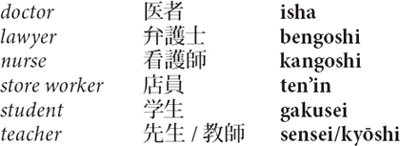
When you are describing yourself or your family, use  ky
ky shi instead of
shi instead of  sensei.
sensei.

Translate the following sentences into Japanese.
1. Mr. Mori ( Mori-san) is a lawyer.
Mori-san) is a lawyer.
2. That person is a Japanese student (a student who is studying the Japanese language).
3. That person is a Japanese student (a student whose nationality is Japanese).
4. That woman is a teacher.
5. That woman is a Japanese teacher (a teacher of the Japanese language).
When you describe a person’s occupation, you can say where the person works. For example, if someone is a high school teacher, you can say either  K
K k
k no sensei desu (He is a high school teacher) or
no sensei desu (He is a high school teacher) or  K
K k
k de hataraite imasu (He works at a high school). The following is a list of types of institutions:
de hataraite imasu (He works at a high school). The following is a list of types of institutions:
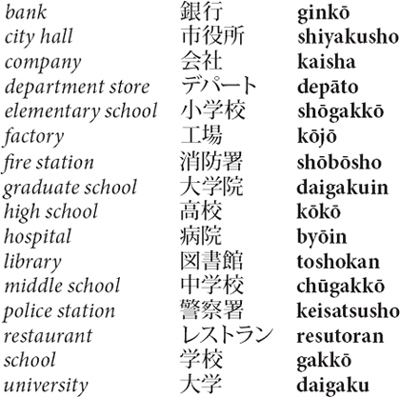

Translate the following sentences into English.
1. 
Buraun-san wa k k
k no Nihongo no sensei desu.
no Nihongo no sensei desu.
2. 
Tanaka-san wa jid sha no k
sha no k j
j de hataraite imasu.
de hataraite imasu.
( jid
jid sha means automobile)
sha means automobile)
3. 
Maiku-san wa dep to no ten’in desu.
to no ten’in desu.

Translate the following sentences into Japanese.
1. Ms. Ishida ( Ishida-san) is a college student.
Ishida-san) is a college student.
2. Mr. Tani ( Tani-san) works at a hospital.
Tani-san) works at a hospital.
3. Ms. Ueda ( Ueda-san) is an English teacher at a high school in Japan.
Ueda-san) is an English teacher at a high school in Japan.
To refer to your own family members, use the plain forms. To refer to someone else’s family members, use the polite forms. You can also use the polite forms for addressing your own family members who are older than you. (See Chapter 1 for how to address one’s older family members.) The following table shows the plain forms and the polite forms you can use for referring to your close family members:
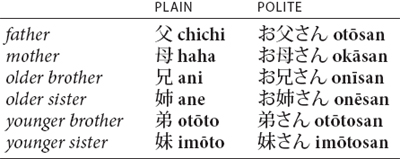

Read the following passage, written by Sachiko, and answer the questions that follow.

Watashi no chichi wa Ch goku-jin desu. Haha wa Nihon-jin desu. Chichi wa T
goku-jin desu. Haha wa Nihon-jin desu. Chichi wa T ky
ky no gink
no gink de hataraite imasu. Haha wa Yokohama no k
de hataraite imasu. Haha wa Yokohama no k k
k no eigo no ky
no eigo no ky shi desu. Ani wa Amerika no daigaku no keizaigaku no gakusei desu.
shi desu. Ani wa Amerika no daigaku no keizaigaku no gakusei desu.
( keizaigaku means economics)
keizaigaku means economics)
1. What is the nationality of Sachiko’s father?
2. What is the nationality of Sachiko’s mother?
3. What does her father do for living?
4. What does her mother do for living?
5. What does her brother do now?

For each of the following, choose the appropriate answer from the options in parentheses.
1. 
Yamada-san no (ane, on san) wa kangoshi desu.
san) wa kangoshi desu.
2. 
Watashi no (chichi, ot san) wa Amerika-jin desu.
san) wa Amerika-jin desu.
3. 
Ano hito wa (Nihon-go, Nihon-jin) desu.
4. 
Ani wa (Nihon-go no gakusei, gakusei no Nihon-go) desu.
5. 
Watashi wa (Ken, Ken-san) desu.
When asking a question in Japanese, you do not need to invert the subject and the verb. Here you learn how to ask and answer simple questions.
To ask a yes/no question, just add the question particle  ka at the end of the statement sentence. For example:
ka at the end of the statement sentence. For example:
Ken-san wa Amerika-jin desu ka.Is Ken an American?
You don’t need a question mark (?) in Japanese, although it is very frequently used.
The answer to a yes/no question usually starts with  hai or
hai or 
 e.
e.  hai means correct or right, so if the question is an affirmative question, it means yes.
hai means correct or right, so if the question is an affirmative question, it means yes. 
 e means wrong, so if the question is an affirmative question, it means no. Their meanings are reversed in answering negative questions.
e means wrong, so if the question is an affirmative question, it means no. Their meanings are reversed in answering negative questions.
The following are possible replies to the affirmative question  Ken-san wa Amerika-jin desu ka (Are you an American, Ken?):
Ken-san wa Amerika-jin desu ka (Are you an American, Ken?):
Hai, Amerika-jin desu.
Yes, I’m an American.
e, Amerika-jin ja arimasen.
No, I’m not an American.
The following are possible replies to the negative question  Kore wa irimasen ka (Don’t you need this?):
Kore wa irimasen ka (Don’t you need this?):
Hai, irimasen.
Right, I don’t need it. (No, I don’t need it.)
e, irimasu.
Wrong, I need it. (Yes, I need it.)
(See Chapter 4 for the verb ending
masu and
masen.)
As you can see, it is very common to omit understood phrases or pronouns in Japanese in replies.
To ask “who?” use the question word  dare or its polite version,
dare or its polite version,  donata. For example:
donata. For example:
Ano hito wa dare desu ka.
Who is that person?
The topic particle  wa cannot be used for question words, so never say
wa cannot be used for question words, so never say  dare wa or
dare wa or  donata wa.
donata wa.

Reorder the items in each set to form a grammatical sentence and then translate it.
1.  desu,
desu,  watashi,
watashi,  gakusei,
gakusei,  wa
wa
2.  haha,
haha,  kangoshi,
kangoshi,  wa,
wa,  desu
desu
3.  Chūgoku-jin,
Chūgoku-jin,  wa,
wa,  ja arimasen,
ja arimasen,  Chen-san
Chen-san
4.  Kankoku-jin,
Kankoku-jin,  desu,
desu,  wa,
wa,  no,
no,  okāsan,
okāsan,  Chen-san
Chen-san
5.  hito,
hito,  ano,
ano,  desu,
desu,  wa,
wa,  ka,
ka,  dare
dare
6.  Yamada-san,
Yamada-san,  hito,
hito,  ano,
ano,  imōtosan,
imōtosan,  desu,
desu,  wa,
wa,  no
no

Read the following passage and state whether each of the sentences that follows is true or false.

Chen-san wa watashi no tomodachi desu. Chen-san wa Ch goku-jin desu. Nihon-go no gakusei desu. Chen-san no ok
goku-jin desu. Nihon-go no gakusei desu. Chen-san no ok san wa kangoshi desu. Chen-san no ot
san wa kangoshi desu. Chen-san no ot san wa eigo no sensei desu. Chen-san no on
san wa eigo no sensei desu. Chen-san no on san wa T
san wa T ky
ky no k
no k koku no kaisha no shain desu.
koku no kaisha no shain desu.
(…  k
k koku means advertisement;
koku means advertisement;  no shain means company employee at …)
no shain means company employee at …)
1. (True, False): Mr. Chen is a Chinese person.
2. (True, False): Mr. Chen’s father works for an automobile company.
3. (True, False): Mr. Chen’s mother is a nurse.
4. (True, False): Mr. Chen’s older brother is an English teacher.

Describe yourself and your family members as much as you can in Japanese.

Two girls, Mika and Alison, are talking. Complete their conversation with the appropriate words.
After you have already met someone for the first time, you use a different greeting than you used upon meeting. You use different forms for greetings depending on the time of day. What you say to a person in parting depends on a number of factors, such as time of day and whether you will see the person again soon.
To greet someone in the morning, say  Ohay
Ohay gozaimasu! (Good morning!). To a close friend or family member, you can just say
gozaimasu! (Good morning!). To a close friend or family member, you can just say  Ohay
Ohay ! (Good morning!). If it’s in the afternoon, say
! (Good morning!). If it’s in the afternoon, say  Konnichi wa!, which means Good afternoon! or Hi! In the evening, say
Konnichi wa!, which means Good afternoon! or Hi! In the evening, say  Konban wa! (Good evening!).
Konban wa! (Good evening!).
When you part, you can say  J
J , mata! (See you later!). If you know that you’ll see the person again on the same day or soon, you can say the location and add the particle
, mata! (See you later!). If you know that you’ll see the person again on the same day or soon, you can say the location and add the particle  de, as in
de, as in  J
J , mata kurasu de! (I’ll see you later in class!). If it is later in the day and you are unlikely to see the person again on the same day, you may add
, mata kurasu de! (I’ll see you later in class!). If it is later in the day and you are unlikely to see the person again on the same day, you may add  Say
Say nara! (Bye!). If you are parting from someone to whom you need to show your respect, you should say
nara! (Bye!). If you are parting from someone to whom you need to show your respect, you should say  Shitsurei shimasu., which literally translates to I’ll be rude but actually means that you are leaving. The Japanese do not say
Shitsurei shimasu., which literally translates to I’ll be rude but actually means that you are leaving. The Japanese do not say  Say
Say nara to their family. When they leave home in the morning, they say
nara to their family. When they leave home in the morning, they say  Itte kimasu!, which literally means I’ll go and come back.
Itte kimasu!, which literally means I’ll go and come back.

Write a Japanese sentence of greeting or parting for each of the following situations.
1. It’s 10 AM. You see your teacher at the library.
2. You’ve just woken up and seen your mother in the kitchen.
3. It’s 9 AM and you are about to leave your home for work. Your mother is sending you off.
4. It’s 5 PM. You talked with your teacher in her office for 15 minutes. You are ready to leave.

Jane Smith sees Professor Hayashi at the library in the morning. Complete their conversation with the appropriate words.
You commonly need to thank people and apologize to them—as well as respond to thanks and apologies. How you do it depends on your relationship.
To thank someone, say  Arigat
Arigat gozaimasu. To thank deeply, you can add the adverb
gozaimasu. To thank deeply, you can add the adverb  d
d mo at the beginning, as in
mo at the beginning, as in  D
D mo arigat
mo arigat gozaimasu. Never say the short version
gozaimasu. Never say the short version  Arigat
Arigat to anyone except your family, subordinate, or very close friends. On the other hand, you can always say just
to anyone except your family, subordinate, or very close friends. On the other hand, you can always say just  D
D mo to thank anyone without sounding rude. In any case, it is a good idea to slightly bow as you say these phrases.
mo to thank anyone without sounding rude. In any case, it is a good idea to slightly bow as you say these phrases.
Common responses to such phrases of appreciation include 
 e (No [problem]) and
e (No [problem]) and  D
D itashimashite (You’re welcome).
itashimashite (You’re welcome).
To apologize, say  Sumimasen or
Sumimasen or  D
D mo sumimasen. You can also say a slightly informal version,
mo sumimasen. You can also say a slightly informal version,  Gomennasai, to your family members or close friends.
Gomennasai, to your family members or close friends.
To respond to apology, you can just respond with 
 e, meaning no need to apologize, if the apology is for something not serious. If the apology is for something rather serious, you can respond to it with
e, meaning no need to apologize, if the apology is for something not serious. If the apology is for something rather serious, you can respond to it with  hai, meaning that you’ll accept his/her apology.
hai, meaning that you’ll accept his/her apology.

What would you say in Japanese in the following situations?
1. You accidentally pushed the person in front of you in a bus.
2. Your neighbor brought homemade cake to your house.
3. You are talking with your Japanese teacher and just realized that you forgot to do your homework that was due today.
4. Your friend just thanked you for helping her carry the big package.
5. Your friend just stepped on your foot and apologized to you.

George accidentally stepped on a woman’s foot in a bus. Read their dialog and choose the appropriate answer from the options in parentheses.

George forgot to do his homework and apologizes to his teacher. Read their dialog and choose the appropriate answer from the options in parentheses.
You can refer to things you and your conversation partner can see by using demonstrative adjectives along with a common noun such as  hon (book) or by using a demonstrative pronoun such as
hon (book) or by using a demonstrative pronoun such as  kore (this one),
kore (this one),  sore (that one near you), or
sore (that one near you), or  are (that one over there).
are (that one over there).
When referring to an item that is close to you, use  kono, as in
kono, as in  kono hon (this book). If it is not close to you but close to your conversation partner, use
kono hon (this book). If it is not close to you but close to your conversation partner, use  sono, as in
sono, as in  sono hon (that book near you). If far from both you and your conversation partner, use
sono hon (that book near you). If far from both you and your conversation partner, use  ano, as in
ano, as in  ano hon (that book over there).
ano hon (that book over there).
The following are some common nouns for things around you:
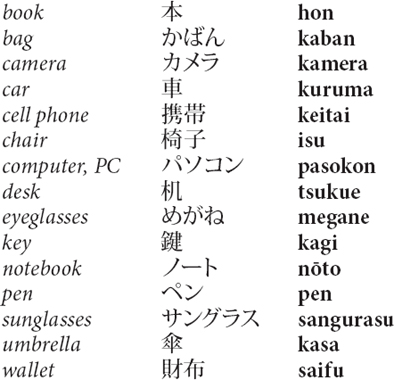
 kore,
kore,  sore, and
sore, and  are
areWhen your conversation partner will know what noun you’re referring to, you don’t have to say the common noun but can use demonstrative pronouns,  kore (this one),
kore (this one),  sore (that one near you), and
sore (that one near you), and  are (that one over there) except when you’re referring to people.
are (that one over there) except when you’re referring to people.
When referring to people, do not use demonstrative pronouns but always use a demonstrative adjective along with a common noun—for example,  ano hito (that person over there). To make it sound polite, you can use
ano hito (that person over there). To make it sound polite, you can use  kata to mean person, after a demonstrative adjective. For example:
kata to mean person, after a demonstrative adjective. For example:
Ano kata wa Tanaka sensei desu.
That person over there is Professor Tanaka.

For each of the following, choose the correct answer from the options in parentheses.
1. 
(Are, Ano) wa Tani-san no kaban desu.
2. 
(Kore, Kono) kuruma wa Doitsu no kuruma desu.
3. 
Watashi no pasokon wa (sore, sono) desu.
4. 
(Ano hito, Are) wa Tanaka-san desu.

For each of the following, choose the correct answer from the options in parentheses.
Sometimes to determine what particular item someone is talking about, you need to ask questions using a question word like which item, what item, and whose item. Remember that question words cannot be marked by the topic particle  wa.
wa.
 dono or
dono or  dore (which)
dore (which)When you want to ask which or which one, you can say  dono or
dono or  dore, as in:
dore, as in:
Dono hon desu ka.
Which book is it?
Which one is it?
Like  kono,
kono,  sono, and
sono, and  ano,
ano,  dono must be followed by a noun.
dono must be followed by a noun.
 nani/nan (what)
nani/nan (what)To ask what, use  , which is read as nani by itself but as nan when followed by
, which is read as nani by itself but as nan when followed by  desu, as in
desu, as in  nan desu ka. For example:
nan desu ka. For example:

Kore wa nan desu ka.
What is this?
 dare no (whose)
dare no (whose)To ask whose, say  dare no, which is
dare no, which is  dare plus the particle
dare plus the particle  no. After the particle
no. After the particle  no, you can drop the common noun if understood. For example:
no, you can drop the common noun if understood. For example:

Kore wa dare no hon desu ka.
Whose book is this?

Kore wa dare no desu ka.
Whose is this?

Translate the following short dialogs into English.
1. A: 
Kore wa dare no kasa desu ka.
B: 
Sore wa Ken-san no kasa desu.
2. A: 
Are wa dare no desu ka.
B: 
Are wa J n-san no desu.
n-san no desu.
3. A: 
Ano kuruma wa dare no kuruma desu ka.
4. A: 
Sumisu-san no wa dore desu ka.
B: 
Are desu.
5. A: 
Ano kuruma wa nan desu ka.
B: 
Are wa Toyota no Kar ra desu.
ra desu.

For each of the following, choose the correct answer from the options in parentheses.
1. 
(Kore, Kono) kuruma wa Nihon no kuruma desu.
2. 
Watashi no wa (sore, sono) desu.
3. A: 
Sore wa nan desu ka.
B: 
(Kore, sore) wa kamera desu.
4. 
Ano hito wa (dare, nan) desu ka.
5. 
Kore wa (dare, nan) desu ka.
6. 
Sore wa (Yamada-san, Yamada-san no) desu ka.

Reorder the items in each set to create a grammatical sentence.
1.  hon,
hon,  chichi,
chichi,  are,
are,  no,
no,  wa,
wa,  desu
desu
2.  kore,
kore,  desu,
desu,  watashi,
watashi,  wa,
wa,  no
no
3.  dare,
dare,  ano,
ano,  gakusei,
gakusei,  ka,
ka,  wa,
wa,  desu
desu
4.  nan,
nan,  sore,
sore,  wa,
wa,  desu,
desu,  ka
ka
5.  Ken-san,
Ken-san,  dore,
dore,  wa,
wa,  desu,
desu,  ka,
ka,  no
no

One rainy day, many umbrellas are in the classroom. Yukiko and George are trying to figure out which one is whose. Complete their conversation as appropriate.